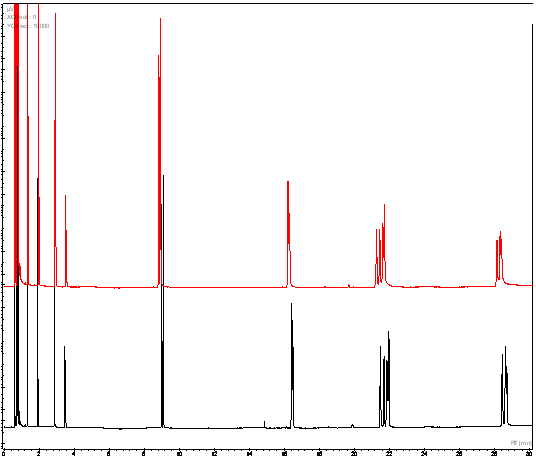Sometimes you just follow the daily routine; you take a new column, put it into the gas chromatograph (GC), adjust all necessary parameters, ignite the flame ionization detector (FID), wait until the system is stable and inject a test mixture. You expect to see something like the chromatogram in Figure 1; instead you get the one similar to Figure 2.

Figure 1: Expected chromatogram

Figure 2: Measured chromatogram with lots of spikes
Spikes appear randomly everywhere in the chromatogram, including places the test mix components elute (see Figure 3).

Figure 3: Spikes also disturb the normal peak shapes, making the peak difficult to integrate
Spikes can come from electronic disturbances that are induced into the electrometer like defective TL lamps, but can also come from particle released somewhere in a system.
In this case we used a steel needle to pierce the quartz jet of the FID from above and obtained better results immediately. Something had blocked the quartz jet, typically graphite flakes from the used graphite ferrules.
The next test was with a more critical separation, resulting in the chromatograms below (Figures 4 and 5).
Figure 4: Real (red) and expected (black) chromatograms of a PAH mix
Figure 5: Magnified peak groups at 22 and 27 minutes retention time (red: real, black: expected)
Figure 5 shows that the peak separation in the red chromatogram is inferior to the expected one. We decided to replace the quartz jet of the injector with a new one and finally acquired a good chromatogram and separation, but saw the rising baseline (Figure 6).

Figure 6: Runs after quartz jet replacement with the FID at 275 °C (red: real, black: expected)
The separation was good again, but we saw the baseline rise more than we would like and decided to increase the detector temperature to 325 °C for conditioning purposes. After that, everything went well again.
Take a look at the old quartz jet (Figure 7):

Figure 7: The old quartz jet (left: uncleaned, right: graphite flakes removed)
Even after removing the bigger graphite particles, some layers of graphite remain on the inside wall of the jet, leading to peak broadening and the baseline rise.
Conclusion
It is important to check the parts of your system on a regular basis to avoid time-consuming troubleshooting. Especially when using graphite ferrules that are already on the column, check to see if there could be graphite flakes released from the ferrules, which would contaminate the quartz jet. It is an option to try to clean a jet first by sonicating in a high boiling organic solvent like toluene or choose the option to always replace the jet with a new one.


